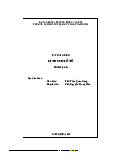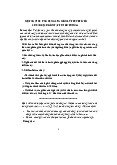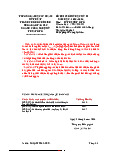






Preview text:
REVIEW CONTENTS
Chapter1: Energy Sources Using in Vehicles
- Internal combustion engine characteristics
Chapter 2: Forces acting on the vehicle
- Pk - Tangential traction force at drive wheel
- Pf1 and Pf2 - Rolling resistance at wheels,
- Mf1 and Mf2- Rolling resistance moment
- Pω - Aerodynamic resistance - Pi - Uphill resistance - Pj - Inertial resistance
- Pm - Resistance force at the towing hook
- Z1 and Z2 - Tangential reaction force of the road surface
acting on the wheels on the front and rear axles Chapter 3 Vehicle Dynamic
- Concept of wheel radius types and tire equation - Dynamics of driven wheels - Dynamics of drive wheels - Slip of drive wheels
Chapter 4: Calculation of Vehicle Traction - Traction balance equation - Traction balance graph - Power Balance equation - Power Balance graph - Level of engine power Using • Dynamic Factor - Dynamic Factor graph
- Dynamic factors graph application
• Effect of vehicle structural parameters on dynamic factor characteristics - Effect of final drive ratio
- Effect of the number of gear ratios Chapter 5: Vehicle Braking
- Criteria for assessing of the braking performance - Braking Force Distribution
- Vehicle stability while brakes Chapter 6: Vehicle Stability
Longitudinal stability of automobiles
- Static longitudinal stability
- Dynamic longitudinal stability
Lateral stability of automobiles
- When moving on a horizontal inclined road
- When cornering on a horizontal inclined road Chapter 7: Vehicle Turning - Turning dynamics
- Understeering, oversteering characteristics Chapter 8: Fuel Consumption - Fuel economy criteria - Fuel consumption equation
- Fuel consumption characteristics of vehicle in steady motion TYPE OF ASSIGNMENTS
I. Determine forces: Traction force, resistance force, reaction force
1.1. A car with total weight G = 53000 N moves uphill with slope angle α = 100 on with rolling
resistance coefficient f = 0.015. Determine the vehicle's rolling resistance force (Pf).
1.2. A vehicle with total weight G = 8050 kG moves on a horizontal asphalt road with rolling resistance
coefficient f = 0.02. Determine the rolling resistance force (Pf) and the changing of Pf when the vehicle
moves uphill on the same road surface and has a slope angle α = 10°.
1.3. A vehicle is moving on the road at speed v = 60 km/h, there is a horizontal wind acting in the
opposite direction of motion with a speed of vg = 4.5 m/s, and the wind direction acting on the vehicl
and vehicle's longitudinal axis is 60°. Determine the aerodynamic resistance force (P).
Given: The aerodynamic drag coefficient K = 0.5625 Ns²/m4; The frontal resistance area F=3.5m².
1.4. Determine the traction force and motion resistance forces acting on the vehicle when moving
in a final gear at a speed of v=60 km/h, acceleration 0.6 m/s², slope 5%.
Given: The total weight G = 6000 kG; frontal resistance area F=2.3 m2; aerodynamic drag coefficient K
= 0.2 Ns²/m4; Vehicle moving in windless environments; rolling resistance coefficient f =0.015. Ignore
the influence of rotating mass.
1.5. Determine the maximum traction force oaf a vehicle when moving in third gear.
Given: The total weight G = 2190 kg; transmission ratio in gear 3 ih3 = 1.58; Maximum torque Memax =
220 Nm; Average working radius of wheel rbx = 0.39 m; Final drive ratio io = 5.125; Transferase ratio ip = 1.94.
1.6. Determine the load acting on the axles of a 2-drive axle vehicle moving on a horizontal roa
surface with a constant speed of 60 km/h.
Given: The rolling resistance coefficient f = 0.015; total weight G = 5300 kg; wheelbase L = 3.3 m;
distance from center of gravity to center of front axle a = 1.84 m; center of gravity height hg = 0.95 m
Average working radius of wheel rbx = 0.42 m; frontal resistance area F = 3.5 m²; aerodynamic dra
coefficient K = 0.7 Ns²/m4; height of center gravity of frontal resistance area hw = 0.98 m.
1.7. Determine the required traction force of a vehicle with total weight G = 5400 kg; moving
uniformly at a speed of 45 km/h uphill α =20°; The road surface has a rolling resistance coefficient f = 0.015.
Given: The car has a frontal resistance area F = 3 m²; Air resistance coefficient K = 0.7 Ns²/m4.
1.8. Determine the traction force and motion resistance forces acting on the vehicle when moving
in a straight at final gear with speed of 90 km/h, acceleration 0.5 m/s2, uphill 2%.
Given: The total weight G = 10000 kG; frontal resistance area F = 3 m2 air resistance coefficient K = 0.4
Ns2/m4; windless; rolling resistance coefficient of the road f = 0.02. Ignore the influence of the rotating mass.
1.9. A 2- drive wheel vehicle moves uniformly downhill a 20° slope angle with a speed v = 70 km/h.
Determine the normal reaction forces of the road surface acting on the wheels.
Given: The total weight of the car G = 12000 N; wheelbase L = 2.5 m; distance from vehicle center o
gravity to front axle center a =1.2 m; vehicle center of gravity height hg =0.7 m; aerodynamic drag
coefficient K=0.25 Ns²/m4; cars have a frontal resistance area F=3.1 m²; height of center of gravity, fronta
resistance area hw = 0.95 m; rolling resistance coefficient f = 0.02; Average working radius of wheel rb = 0.35 m.
II. Determine maximum speed of vehicle
2.1. Determine the maximum speed of a vehicle.
Given: final gear ratio is 1, final drive ratio i0 = 7; Average working radius of wheel rbx= 0.5 m; total
weight G = 2500 kG; air resistance coefficient K= 0.8 Ns²/m4; frontal resistance area F = 2.5 m²
transmission efficiency ηTL = 0.8; Maximum power Nemax = 120 kW at 5000 rpm; Gasoline engine with
no speed limit; rolling resistance coefficient f = 0.02; ignore the effect of speed on rolling coefficient;
Vehicle moves in windless environments. 2.2.
A vehicle has total weight G = 3500 kg; traction torque at the drive wheel Mk = 450 Nm; frontal
resistance area F = 3.5 m²; aerodynamic drag coefficient K = 0.7 Ns²/m4; average working radius of the
wheel rbx = 0.3 m; rolling resistance coefficient f = 0.02.
Determine the vehicle speed when moving uniformly on a horizontal road without wind and when driving
uphill on a 5% slope with wind acting in the same direction of the vehicle's motion as 10 km/h wind
speed. Ignore the effect of speed on the rolling resistance coefficient. III. Determine uphill ability 3.1.
Determine the go uphill ability when the vehicle moves uniformly in the last gear (ih=1) at speed v = 90 km/h.
Give final drive ratio i0 = 5; total weight G = 2700 kg; Average working radius of wheel rbx= 0.3 m; air
resistance coefficient K = 0.2 Ns²/m4; frontal resistance area F = 2.4 m²; powertrain efficiency t = 0.8
Maximum power Nemax= 180 kW at 4000 rpm; diesel engine; rolling resistance coefficient of the road f 0.015. 3.2.
Determine the vehicle's maximum go uphill ability
Given: The maximum torque Memax = 200 N.m; total weight G = 6000 kg; The first gear ratio is ih1 = 4;
final drive ratio i0 =5; power transmission efficiency ηt=0.8; Average working radius of the wheel rbx=
0.25 m; rolling resistance coefficient f =0.015; ignore air resistance force. 3.3.
Determine the maximum acceleration of a vehicle in 1st gear.
Give: maximum torque of the engine Memax = 17 kg.m; total weight of vehicle G = 5400 kg, first gear
ratio ih1 = 4.5; final drive ratio i0= 6.0; powertrain efficiency ηt = 0.85; Average working radius of wheel
rbx= 0.33 m; rolling resistance coefficient of the road f = 0.02; ignore air resistance force. Ignore the
influence of the rotating mass. 3.4.
Determine the go uphill ability when the vehicle moves uniformly in the last gear (ih=1) at speed V = 70 km/h
Given: final drive ratio i0 = 6.5; total weight G = 10000 kG; Average working radius of wheel rbx = 0.5m:
air resistance coefficient K = 0.5 Ns2/m4; frontal area F = 4 m2: powertrain efficiency = 0.85; Maximum
power Nemax= 110 kW at 3200 rpm; Diesel engine: rolling resistance coefficient f = 0.015. 3.5. Determine the maximum go uphill ability
Give: maximum torque of engine Memax = 17 kG.m: total weight of vehicle G = 5400 kG; first gear ratio
ih1 = 4.5. final drive ratio i0 = 6; Powertrain efficiency = 0.85; Average working radius of wheel rbx =
0.33m, road rolling resistance coefficient f= 0.02: ignore air resistance force.
IV. Determine Transmission Ratio 4.1. Determine the of the forward gears transmission ratio
Given: the gearbox has 5 forward gears, the last gear ratio is 1, the intermediate gears are distributed
exponentially; final drive ratio i0 = 6.9. Average working radius of wheel rbx = 0.5 m; Maximum torque
Memax = 200 Nm; total weight G = 7000 kG; Rear axle drive, Adhesion weight G = 5000 kG; powertrain
efficiency = 0.8; total road resistance coefficient the vehicle
max = 0.25; adhesion coefficient = 0 8. 4.2.
Determine the gear ratios of the powertrain system of a vehicle moving on a horizontal road with Vmax = 90 km/h.
Given: The rolling resistance coefficient f = 0.015; Total weight G = 1650 kG: frontal resistance area F =
3.2 m2, aerodynamic resistance coefficient K = 0.75 Ns2/m4, powertrain efficiency = 0.9: average
working radius of the wheel rbx = 0.36 m; Mev = 127 Nm at 4000 rpm. 4.3.
Determine the transmission ratio of the forward gears in the transmission
Given: The transmission has 5 forward gears, the last gear is the direct ratio (ih5=1), the intermediate ge
are distributed exponentially; final drive ratio i0 = 4: average working radius of wheel rbx = 0.32 m;
Maximum torque Memax = 450 Nm: total weight G = 2100 kG; Rear axle drive, Adhesion weight G =
1400 kG; Powertrain efficiency = 0.9; Total road resistance coefficient = 0.35; adhesion coefficient max = 0.6. V. General Cases 5.1
A rear-axle drive vehicle with weight G = 16000 N; Average working radius of wheel rbx = 0.3m;
wheelbase L = 2.6 m; distance from center of gravity to center of front axle a = 1.2 m; center of gravit
height hg = 0.6 m; final drive ratio i0= 8; powertrain efficiency = 0.9; frontal barrier area F = 2.6 m²; air
resistance coefficient K = 0.3 Ns²/m4; center height of frontal resistance area hω = 0.9 m; The road surfa
has a rolling resistance coefficient f = 0.02. The car moves steadily at a speed v = 200 km/h on the ro
without wind; the adhesion coefficient between wheels and road surface φ= 0.8.
1. Draw a diagram of the forces acting on the vehicle.
2. Determine the traction force on the drive wheel and the required torque of the engine.
3. Will the drive wheels slip if the road surface has an adhesion coefficient of φ=0.4? 5.2
A vehicle has total weight G = 1
1550 kG; final drive ratio i0 = 7.32; first gear ratio is ih1 = 5.181;
powertrain efficiency η = 0.9; Average working radius of the wheel rbx= 0.42 m; Maximum torque M 4
emax=45 kGm; frontal resistance area F=3.59 m²; air resistance coefficient K = 0.4 Ns²/m ; rolling
resistance coefficient f = 0.02. Let's define:
1. Resistance forces and traction force when the vehicle moves uniformly at 40 km/h uphill; slope i = %; windless
2. Maximum slope angle according to engine torque conditions? 5.3
A rear-wheel drive vehicle with weight G = 15000 N; wheel radius rb = x 0.3 m; Maximum power
of engine Nemax= 220 kW at 6000 rpm; Manual transmission with final gear is ih=1; final drive ratio i0=
4; powertrain efficiency η = 0.9; air resistance coefficient K=0.25 Ns²/m4; frontal resistance area F = 2.5
m²; rolling resistance coefficient f= 0.02. The vehicle moves steadily without wind in maximum engine
power mode and final gear ratio. 5.4 Let's define:
1. Draw a diagram of the forces acting on the vehicle?
2. Traction force on drive wheels? 3. Resistance forces? VI. BRAKING DYNAMIC
6.1. A vehicle is moving at a speed of 50 km/h on a flat road, longitudinal adhesion coefficient
= 0.65. Ignore the influence of the rotating mass; rolling resistance, and wind resistance. Please determine:
1. Maximum braking deceleration; Minimum braking time and minimum braking distance.
All wheels reach the limit of traction. 2. Total braking distance
Give: reaction time of driver 0.5 s; brake system delay time 0.3 s; brake force increase s time
0.4 s; Brake on all wheels, braking force uses 50% of traction.
6.2. A vehicle moves on the road at a speed of 80 km/h, longitudinal adhesion coefficient = 0.7.
Ignore the effects of rotating mass, rolling resistance, and wind resistance.
1. Determine maximum braking acceleration; Minimum braking time and minimum braking
distance? brake force at all wheels to reach the adhesion force; Gravitational acceleration g = 9.81m/s2.
2. Vehicle speed at the end of the braking process
3. Draw the vehicle's actual braking diagram?
Given: Time to increase braking force 0.4 s; brake holding time 3 s; braking force uses 80% of adhesion force.
6.3. Determine the total braking distance.
Given: braking force on all wheels, braking force uses 80% of adhesion force; Vehicle speed at
the braking applied is V0= 54 km/h: reaction time 0.2s; delay time of effect 0.1s; brake force
increases time 0.2s; Road adhesion coefficient = 0.7; Ignore rolling resistance, wind resistance
and ignore the influence of rotating mass.
6.4. A vehicle moving at a speed V0 = 108 km/h brakes quickly. Suppose the braking deceleration
reaches to maximum value Jpmax = 0.8.g. Driver's reaction time t1 = 0.4 s; delay time of braking
system t2 = 0.2 s. Determine the vehicle's braking distance.



